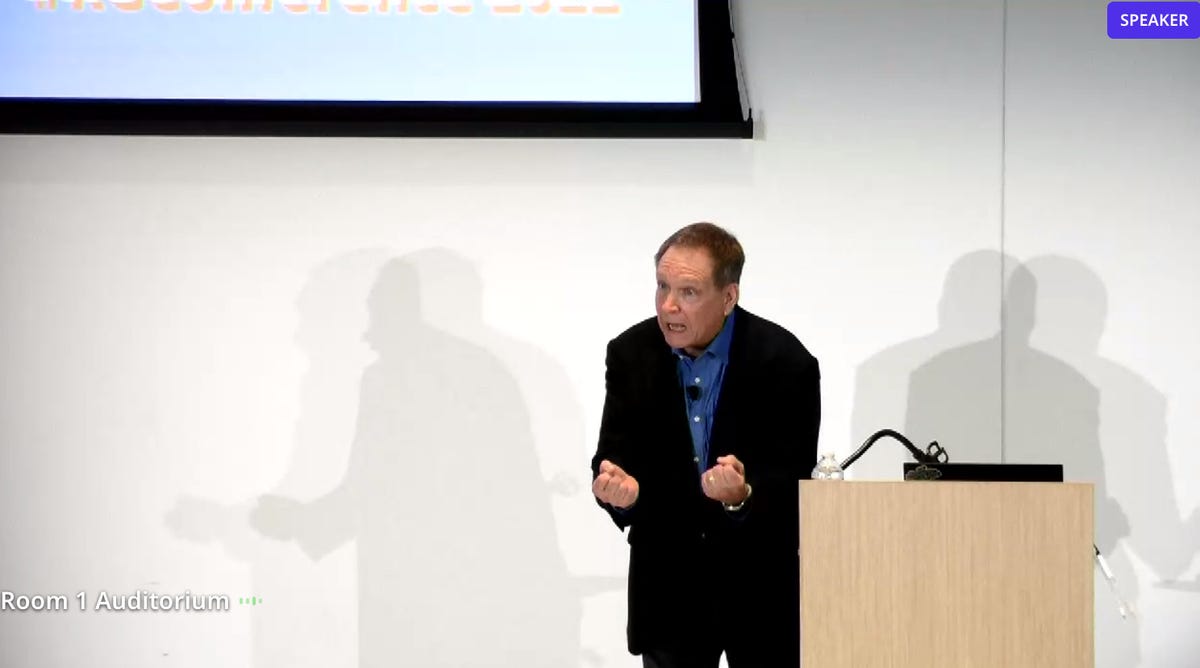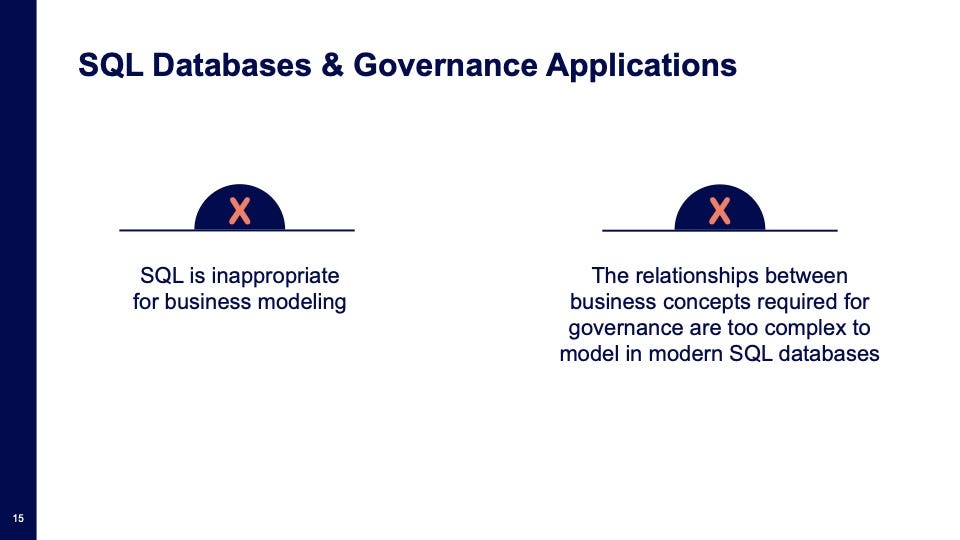
Bob Muglia says twenty years of work on database innovation will bring the relational calculus of E.F. Codd to knowledge graphs, what he calls “relational knowledge graphs,” to revolutionize business analysis.
Relational AI
Bob Muglia is something of a bard of databases, capable of unfurling sweeping tales in the evolution of technology.
That is what Muglia, former Microsoft executive and former Snowflake CEO, did Wednesday morning during his keynote address at The Knowledge Graph Conference in New York.
The subject of his talk, “From the Modern Data Stack to Knowledge Graphs,” united roughly fifty years of database technology in one new form.
The basic story is this: Five companies have created modern data analytics platforms, Snowflake, Amazon, Databricks, Google, and Azure, but those data analytics platforms can’t do business analytics, including, most importantly, representing the rules that underly compliance and governance.
“The industry knows this is a problem,” said Muglia. The five platforms, he said, representing “the modern data stack, have allowed a “new generation of these very, very important data apps to be built.” However, “When we look at the modern data stack, and we look at what we can do effectively and what we can’t do effectively, I would say the number one problem that customers are having with all five of these platforms is governance.”
Also: Ethernet creator Metcalfe: Web3 will have all kinds of ‘network effects’
Muglia, who ran the SQL Server business at Microsoft, among other feats in a 30-year career building databases, gave illustrations of business rules the data platforms can’t model.
“So, if you wanted to perform a query to say, ‘Hey, tell me all of the resources that Fred Jones has access to in this organization’ — that’s a hard query to write,” he said. “In fact, it’s a query that probably can’t execute effectively on any modern SQL database if the organization is very large and complex.”
The problem, said Muglia, was that the algorithms based off of structured query language, or SQL, can’t do such complex “recursive” queries.

As a kind of bard of database technology, Muglia often conveys technical detail with rhetorical flourishes: Binary Join! Binary Join! Binary Join!
The Knowledge Graph Conference 2022
“There have been many generations of algorithms built that have all been created around the idea of a binary one,” said Muglia. “They have two tables with the key to join the two together, and then you get a result set, and the query optimizer takes and optimizes the order of those joins — binary join, binary join, binary join!”
The recursive problems such as Fred Jones’s permissions, he said, “cannot be efficiently solved with those algorithms, period.”
The right structure for business relationships, as distinct from data relationships, said Muglia, is a knowledge graph.
“What is a knowledge graph?” asked Muglia, rhetorically. He offered his own definition for what can be a sometimes mysterious concept. “A knowledge graph is a database that models business concepts, the relationships between them, and the associated business rules and constraints.”
Muglia, now a board member for startup Relational AI, told the audience that the future of business applications will be knowledge graphs built on top of data analytics, but with the twist that they will use the relational calculus going all the way back to relational database pioneer E.F. Codd.
“Go back to the beginning,” urged Muglia. “What is the fundamental algorithmic capability of relational technology, what can be done with it?”

There are five platforms for analytics built on SQL, noted Muglia, but none of those on their own can do business analysis, as opposed to data analysis.
Relational AI
“If we look at what Codd was creating in the 1970s, the theorem said that relational algebra and relational queries are precisely equivalent in expressive power — so interesting! I always knew this was interesting, and now I know why.”
Using Relational AI’s technology, in particular the technology developed by founder and CEO Molham Aref for query optimization, said Muglia, combined with knowledge graphs, it’s possibel to bring the same relational algebra to the organization of business concepts.
“If we moved to relational knowledge graphs, we now go to the fundamentals of relational calculus, and we issue relational calculus statements that are unordered and they contain business rules and constraints.”

SQL is not going away, but it can’t really handle the queries of business analysis, said Muglia.
Relational AI
The work to “fundamentally redefine how we can use relational algebra,” said Muglia, has been going on for roughly 20 years, but picked up steam in 2010 with work by Aref, and inside numerous universities and companies, with hundreds of papers published on the topic, he said.
“It’s been an incredible cooperative effort among the research communities across the world,” he said. “Materialize uses it in a fundamental way inside inside the Materialization that they perform. LinkedIn adopted some of this through a graph database they use called Liquid.”
The relational knowledge graph introduces a new language, called Rel, although, “SQL remains important,” Muglia said, “SQL is not going away,” as it serves as a kind of on-ramp to the new world of the relational knowledge graph.
“I can even argue that the best days of SQL are ahead of it.”
Muglia foresees “amazing, amazing potential from a perspective of software development, and all kinds of things come from this,” he said of the relational knowledge graph. “As the technology matures — and I want to focus on the fact that it is not yet mature — but as the technology matures, we’re going to see things we can do with it we couldn’t even dream of.”
That includes much more use of machine learning within business analytics, as the name Relational AI implies. In addition, the business model, Muglia said, will no longer be “just something we put up on a whiteboard that an engineer needs to look at to write some Java code against.”
“The model,” said Muglia, “becomes the program, and so business analysts can become involved, and make changes to the data structures.”
“Think about thousands of people getting involved who know about the business — think about that!”
Right now, Relational AI’s technology is “pretty white glove,” he said. “We have a number of organizations we’re doing limited trials with,” and the company hopes to “open it up for self-service” next year with “a broad developer beta so people can sign up and begin to use the system.” That is the same trajectory, he said, as when he was running Snowflake in 2014 and it released early versions of its code.
“We’re at the start of a whole new era,” said Muglia. “It’s like the modern data stack in 2013, 2014 — that’s where we are in that lifecycle.
“And just like the modern data stack has revolutionized analytics, I’m completely convinced that knowledge graphs, and, in particular, relational knowledge graphs, are going to transform the way business runs.”
The Knowledge Graph Conference is in its fourth year, having begun life as a small affair in a ballroom at Columbia University in 2019. This year, after two years of virtual-only proceedings, the conference has blossomed into a sprawling hybrid event, with dozens of panels as well as live sessions at the Cornell Tech campus on Roosevelt Island in New York City. The program runs through May 6th .























